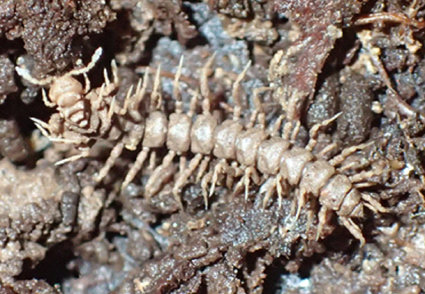Abstract
During several collecting surveys for terrestrial micro-molluscs across Trinidad and Tobago, millipedes of the genus Pandirodesmus were taken by MR on both islands. Samples of P. rutherfordi Shelley & Smith, 2015, from Tobago, were recovered in addition to those containing a new species from Trinidad: Pandirodesmus jaggernauthi sp. nov. Additional records, illustrations, and descriptive notes are given for P. rutherfordi. A key is presented to all three species of the genus, and their distributions are mapped.
References
Adis, J. (Ed.) (2002) Amazonian Arachnida and Myriapoda. Pensoft, Sofia-Moscow, 590 pp.
Adis, J. & Golovatch, S.I. (2000) Notes on the unique structure of the spiracles and legs in Pandirodesmus disparipes Silvestri, 1932 (Diplopoda, Polydesmida, Chelodesmidae) with possible implications concerning its mode of life. Fragmenta Faunistica, 43 (9), 97–108. https://doi.org/10.3161/00159301FF2000.43.9.097
Attems, C. (1940) Myriapoda 3, Polydesmoidea III. Fam. Polydesmidae, Vanhoeffeniidae, Cryptodesmidae, Oniscodesmidae, Sphaerotrichopidae, Peridontodesmidae, Rhachidesmidae, Macellolophidae, Pandirodesmidae. Das Tierreich, 70, 1–576 + i–xxxii. https://doi.org/10.1515/9783111609645
Enghoff, H., Dohle, W. & Blower, J.G. (1993) Anamorphosis in millipedes (Diplopoda)—the present state of knowledge with some developmental and phylogenetic considerations. Biological Journal of the Linnean Society, 109, 103–234. https://doi.org/10.1111/j.1096-3642.1993.tb00305.x
Golovatch, S.I. & Kime, R.D. (2010) Millipede (Diplopoda) distributions: A review. Soil Organisms, 81 (3), 565–597. [for 2009]
Helmer, E.H., Ruzycki, T.S., Benner, J., Voggesser, S.M., Scobie, B.P., Park, C., Fanning, D.W. & Ramnarine, S. (2012) Detailed maps of tropical forest types are within reach: forest tree communities for Trinidad and Tobago mapped with multiseason Landsat and multiseason fine-resolution imagery. Forest Ecology and Management, 279, 147–166. https://doi.org/10.1016/j.foreco.2012.05.016
Hoffman, R.L. (1980) Classification of the Diplopoda. Muséum d’histoire naturelle, Genève, 237 pp. [for 1979]
Shelley, R.M. & Smith, J.M. (2015) The enigmatic milliped genus Pandirodesmus Silvestri 1932 and description of a new species from Tobago represented by males (Polydesmida: Leptodesmidea: Chelodesmidae: Chelodesminae: Pandirodesmini). Insecta Mundi, 0444, 1–15.
Silvestri, F. (1932) A new and extraordinary genus of the diplopod family, Polydesmidae, from British Guiana. American Museum Novitates, 564, 1–12.


